Drills to teach the single-post offense
Almost all our team shooting drills will incorporate actions or concepts out of our single-post offense. Practicing the field goals you attempt in a game will only increase your shooting percentage. Furthermore, the proper execution of these breakdown drills requires focus and attention to detail and can enhance your conditioning. Improvement in those areas will increase your chances of being a more efficient offensive team.
The game of basketball is constantly evolving and, as coaches, we must evolve with it. Today, “positionless” basketball is the latest movement. Identifying and developing a player that can play with their back to the basket effectively is a difficult task; finding two is next to impossible. The single-post offense is an excellent option for your team if you have multiple perimeter players who have similar skill sets. Here are several drills that will teach your team this style of play.
V-cut to rip-and-go
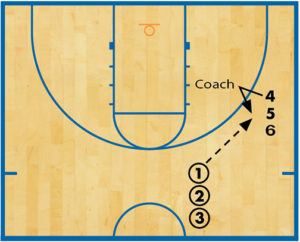 DIAGRAM 1: Our first drill emphasizes the footwork that is necessary for the wing to get open and receive the entry pass. We have an assistant coach or manager play token defense and, if possible, hold a blocking pad. The offensive player (4) will step into the defender and make contact with the pad before breaking out to the wing and receiving a pass from 1.
DIAGRAM 1: Our first drill emphasizes the footwork that is necessary for the wing to get open and receive the entry pass. We have an assistant coach or manager play token defense and, if possible, hold a blocking pad. The offensive player (4) will step into the defender and make contact with the pad before breaking out to the wing and receiving a pass from 1.
 DIAGRAM 2: After catching the pass, the ball handler will rip or sweep the ball below their knees and execute a one-dribble, pull-up jumper. The passer and shooter change lines. You can incorporate as many different shots as you like (i.e. step-back jump shots, or different finishes at the rim).
DIAGRAM 2: After catching the pass, the ball handler will rip or sweep the ball below their knees and execute a one-dribble, pull-up jumper. The passer and shooter change lines. You can incorporate as many different shots as you like (i.e. step-back jump shots, or different finishes at the rim).
Logo cut to Chicago cut
 DIAGRAM 3: Form two lines with both slot positions being occupied. The slot with the ball (1) dribbles at the other slot (4), who makes a logo cut.
DIAGRAM 3: Form two lines with both slot positions being occupied. The slot with the ball (1) dribbles at the other slot (4), who makes a logo cut.
 DIAGRAM 4: After the slot-to-slot pass is completed, the passer will follow the pass and make a Chicago cut. The recipient of the pass will time their dribble, rubbing right off the cutter’s back and into an elbow area jump shot.
DIAGRAM 4: After the slot-to-slot pass is completed, the passer will follow the pass and make a Chicago cut. The recipient of the pass will time their dribble, rubbing right off the cutter’s back and into an elbow area jump shot.
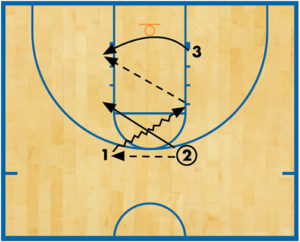 DIAGRAM 5: Here, we add a third line to incorporate the post. We initiate the drill with a Chicago cut, as the slot (1) drives the ball to the elbow area, the post (3) circles behind the defense for a drop-off bounce pass from 1.
DIAGRAM 5: Here, we add a third line to incorporate the post. We initiate the drill with a Chicago cut, as the slot (1) drives the ball to the elbow area, the post (3) circles behind the defense for a drop-off bounce pass from 1.
Fire action: backdoor cut
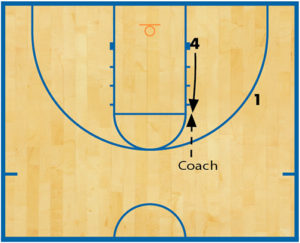 DIAGRAM 6: This is another two-line drill with the ball-side wing and post being occupied. Coaches or managers can make the entry pass. The post (4) flashes to the elbow and receives the entry pass from the coach or manager.
DIAGRAM 6: This is another two-line drill with the ball-side wing and post being occupied. Coaches or managers can make the entry pass. The post (4) flashes to the elbow and receives the entry pass from the coach or manager.
 DIAGRAM 7: On the catch, the wing (1) cuts backdoor and receives a bounce pass from 4.
DIAGRAM 7: On the catch, the wing (1) cuts backdoor and receives a bounce pass from 4.
Make sure the post leads the wing with his pass. A pass thrown behind a teammate who is making a backdoor cut will surely be stolen. The post player does not have to pivot at all to complete the pass. He or she simply needs to twist their torso and execute the pass as soon as they catch the ball. When the timing is done correctly, the success rate of backdoor plays increases dramatically.
Fire action: flare screen
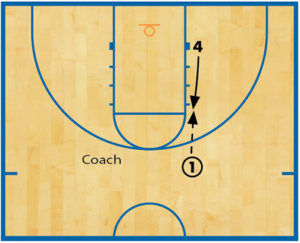 DIAGRAM 8: This is our final two-line breakdown drill with the post and the ball-side slot lines being filled. The post (4) flashes to elbow area, and the slot (1) hits them with a pass.
DIAGRAM 8: This is our final two-line breakdown drill with the post and the ball-side slot lines being filled. The post (4) flashes to elbow area, and the slot (1) hits them with a pass.
 DIAGRAM 9: The coach or manager then sets a flare screen for the slot. The post hits the slot with a skip pass. Since this drill simulates our fire action, have your post look for the backdoor cut first before making the skip pass for a jump shot off the flare screen.
DIAGRAM 9: The coach or manager then sets a flare screen for the slot. The post hits the slot with a skip pass. Since this drill simulates our fire action, have your post look for the backdoor cut first before making the skip pass for a jump shot off the flare screen.
Swing/swing/swing attack drill
 This four-line drill reinforces the don’t-be-a-ball-stopper notion and allows your team to practice many different shots and actions. Start with the movements shown in DIAGRAMS 10 and 11.
This four-line drill reinforces the don’t-be-a-ball-stopper notion and allows your team to practice many different shots and actions. Start with the movements shown in DIAGRAMS 10 and 11.
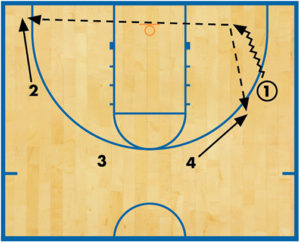 DIAGRAM 12: After the ball has been reversed and is back in 1’s hands, they can shoot the ball or drive the ball to the baseline and look for the weak-side wing (2) on the drive and drift action or the ball-side slot (4), who will follow the ball as it’s being dribbled away from them.
DIAGRAM 12: After the ball has been reversed and is back in 1’s hands, they can shoot the ball or drive the ball to the baseline and look for the weak-side wing (2) on the drive and drift action or the ball-side slot (4), who will follow the ball as it’s being dribbled away from them.
If your team is more advanced and you have an assistant coach or team managers, you can attempt both of these shots simultaneously by placing a coach with a basketball right on the baseline in the exact spot the wing will drive the ball to. Whichever pass the wing does not make, the coach will complete. This will increase the awareness and concentration levels of your team along with the number of repetitions your players make. If the wing drives the ball to the middle of the floor, he or she can shoot a pull-up jumper or penetrate and pitch to the weak-side slot for a jump shot.
Step-up ball-screen drill
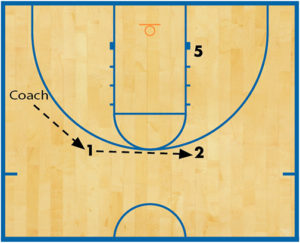 DIAGRAM 13: This is a three-line, two-shot drill. A coach or manager will initiate the action by passing the ball to the slot (1). Next, there is a slot-to-slot pass, and on the flight of the ball to the slot (2), the post sprints into a ball screen for 2.
DIAGRAM 13: This is a three-line, two-shot drill. A coach or manager will initiate the action by passing the ball to the slot (1). Next, there is a slot-to-slot pass, and on the flight of the ball to the slot (2), the post sprints into a ball screen for 2.
 DIAGRAM 14: As 2 uses the ball screen, there is a second coach or manager with a basketball that always hits the post (5) rolling hard to the front of the rim. The slot without the basketball (1) follows the ball as it is dribbled away from him or her.
DIAGRAM 14: As 2 uses the ball screen, there is a second coach or manager with a basketball that always hits the post (5) rolling hard to the front of the rim. The slot without the basketball (1) follows the ball as it is dribbled away from him or her.
 DIAGRAM 15: The slot with the basketball will make the throwback pass and 1 will shoot a jump shot. You can always adjust who makes which pass. In other words, the coach can make the throwback pass and the slot with the basketball (2) can hit the post rolling hard to the rim. You can also tweak which side the ball screen is set on (DIAGRAM 16) to address your roll/rise action from different angles and spots.
DIAGRAM 15: The slot with the basketball will make the throwback pass and 1 will shoot a jump shot. You can always adjust who makes which pass. In other words, the coach can make the throwback pass and the slot with the basketball (2) can hit the post rolling hard to the rim. You can also tweak which side the ball screen is set on (DIAGRAM 16) to address your roll/rise action from different angles and spots.
Slot-is-denied drill
 In this final drill, we prepare for those teams that will attempt to play passing lane defense. This is a four-line drill and quick ball movement with hard, sharp cuts are emphasized.
In this final drill, we prepare for those teams that will attempt to play passing lane defense. This is a four-line drill and quick ball movement with hard, sharp cuts are emphasized.
DIAGRAM 17: The slot (2) enters the ball to the wing (1), and he or she makes their traditional cut to the weak side of the court.
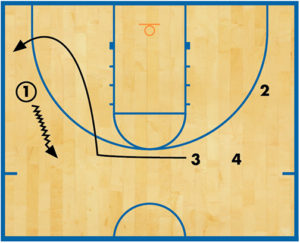 DIAGRAM 18: The weak-side slot (3) spaces over, realizes they are denied and immediately makes a backdoor cut. If your resources permit, you can have a coach or manager standing right next to the wing with the ball (1) to complete a pass to the slot making a backdoor cut. In this illustration, the wing with the ball (1) dribbles to the slot area and makes a slot-to-slot pass to 4 (DIAGRAM 19), who has spaced up from the weak-side wing. On the catch, 4 executes a sweep-and-go move and attacks the defense by dribbling into the gap. The ball-side wing (2) reads their teammate and drifts into the corner, making it more difficult for their defender to help-and-recover, and he or she prepares to shoot the ball if it’s passed to them.
DIAGRAM 18: The weak-side slot (3) spaces over, realizes they are denied and immediately makes a backdoor cut. If your resources permit, you can have a coach or manager standing right next to the wing with the ball (1) to complete a pass to the slot making a backdoor cut. In this illustration, the wing with the ball (1) dribbles to the slot area and makes a slot-to-slot pass to 4 (DIAGRAM 19), who has spaced up from the weak-side wing. On the catch, 4 executes a sweep-and-go move and attacks the defense by dribbling into the gap. The ball-side wing (2) reads their teammate and drifts into the corner, making it more difficult for their defender to help-and-recover, and he or she prepares to shoot the ball if it’s passed to them.
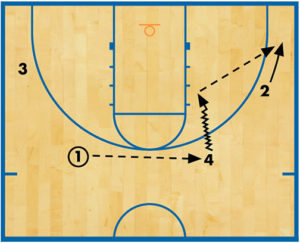 Another variation of this drill would be for 4 to swing the ball to 2 and have that player drive the ball for baseline drive-and-drift action with 3 or middle drive the ball for a penetrate-and-pitch jump shot to the weak-side slot (1).
Another variation of this drill would be for 4 to swing the ball to 2 and have that player drive the ball for baseline drive-and-drift action with 3 or middle drive the ball for a penetrate-and-pitch jump shot to the weak-side slot (1).
Michael Murphy is a basketball coach and co-founder of the Revolution Basketball training academy in Illinois. He also is a member of Winning Hoops’ editorial advisory board.









